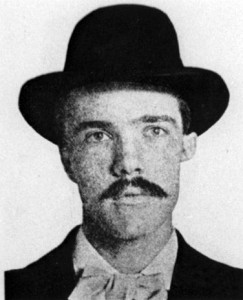
"Theodore Durrant was this morning for the second time sentenced to be hanged." (Image by Jay Robert Nash Collection.)
The sensational Durrant trial of 1895, in which a medical student was accused of committing a pair of murders in the Emmanuel Baptist Church in San Francisco, brought the city to a standstill and generated national news attention. The following are excerpts from stories about the case that appeared in the Brooklyn Daily Eagle.
••••••••••
“Durrant and Miss Williams” (April 23, 1895): “The preliminary examination of W.N.T. Durrant, the medical student accused of murdering Miss Marian Williams in Emmanuel Baptist Church, on the night of April 12, was resumed this morning. There was a new witness, who gave most damaging evidence against him. It will be remembered that Durrant had strenuously denied having met Miss Williams for three weeks prior to her death. There has been evidence that he was seen in the vicinity of the church that night by one man, three girls and a woman, but only one of these, a young girl, has stated that she recognized Durrant, but her testimony is weakened by that of a companion, who was with her at the time, and failed to recognize the prisoner in court.”
••••••••••
“Damaging to the Pastor” (April 25, 1895): “A new discovery in the Durrant case has been made. When the body of Minnie Williams was found in Emmanuel Church, in searching after traces of the murderer, the police and reporters found a dark stain on the door of the Rev. Dr. Gibson’s study, to which he only, so far as known, had a key. The police say the stain was merely varnish and have paid no further attention to it. Yesterday, however, a reporter shaved off a portion of the varnish stains and a microscopic examination showed it was blood instead of varnish.”
••••••••••
“Police Stop the Play” (July 30, 1895): “The production of a new play entitled The Crime of a Century, which was placed on the stage of the Alcatraz theater last night, was stopped in the middle of the third act. Just at the point when Debois, the character who is supposed to impersonate Durrant, was about to drag a woman to the belfry of a church, Sheriff Whelan and his deputies marched on the stage and arrested the performers, eleven in all. The manager of the theater was also placed under arrest.
The manager stepped before the curtain and made a speech in which he claimed that he had a right to produce the play. He was taken into custody nevertheless for disobeying the order made by Judge Murphy restraining him from putting the piece on the stage. A great crowd attended the performance, which was hissed at intervals. The whole company spent the night in jail.”
••••••••••
“Durrant Writes a Book” (November 6, 1895): “Theodore Durrant has written a sketch of his life and ambitions and has gone into the matter of how it feels to be on trial for murder. He has some flings at the curious people who stared at him, takes the churches to task for what he thinks is their lack of Christianity, and says that his self possession, nerve and fortitude during the trial were due to the love and comfort given him by his mother. He stoutly proclaims his innocence and satirizes some of his critics.”
••••••••••
“Durrant Resentenced” (April 11, 1897): “Theodore Durrant was this morning for the second time sentenced to be hanged for the murder of Blanche Lamont in Emmanuel Church two years ago. He will be hanged at San Quentin prison on June 11.”
••••••••••
 “Hallucinations of a Hangman” (November 7, 1899): “Amos Lunt of San Quentin is going to a sanitarium, a victim of insomnia and something like nervous prostration, but it is doubtful if it will do him any good. Lunt is the hangman of the San Quentin prison, with a record of twenty executions in five years, and his present condition is induced by hallucinations. Every time he falls into a doze he sees the spirits of some of the murderers whom he has hanged, especially the spirit of Durrant, who murdered two girls in a church, and the hunchback John Miller.”
“Hallucinations of a Hangman” (November 7, 1899): “Amos Lunt of San Quentin is going to a sanitarium, a victim of insomnia and something like nervous prostration, but it is doubtful if it will do him any good. Lunt is the hangman of the San Quentin prison, with a record of twenty executions in five years, and his present condition is induced by hallucinations. Every time he falls into a doze he sees the spirits of some of the murderers whom he has hanged, especially the spirit of Durrant, who murdered two girls in a church, and the hunchback John Miller.”
•••••••••••
“The Death Penalty” (August 16, 1901): “There is a growing appreciation of the fallibility of circumstantial evidence, as well as of the uncertainty of witnesses. The terrible fate which sent young Durrant to the gallows for a murder of two girls, committed by the pastor of the church in which their bodies were found, has its effects on minds disposed to caution, if not to mercy.”
Tags: Amos Lunt, Theodore Durrant

